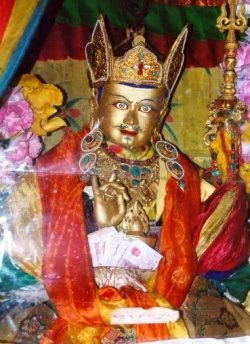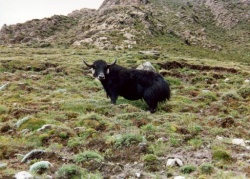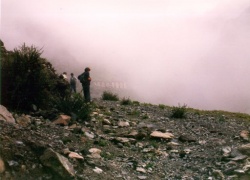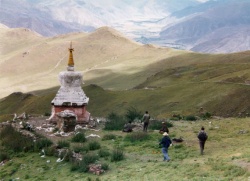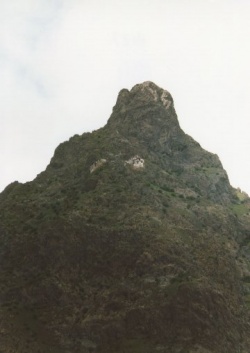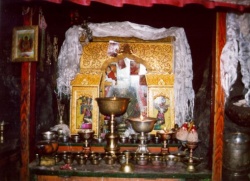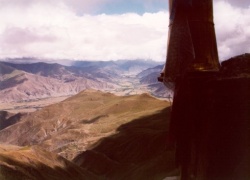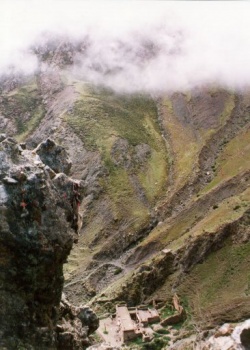The Crystal Cave of Guru Rinpoche (Shel-Drak)
One pilgrimage spot that everyone tried to talk me out of going to was the legendary Crystal Cave (Shel Drak) of Guru Rinpoche on Crystal Mountain, a key pilgrimage site for Tibetans, in particular those of the Nyingma Lineage. It is said to represent Guru Rinpoche—s Buddha attributes. After all, this was Guru Rinpoche's first meditation cave in Tibet. It was here that he bound the demons and B—n influences under oath. Many termas were hidden and revealed here to practitioners like Orgyen Lingpa and others. I felt I had to go there.
Both of the experienced Tibet trekkers that I knew said it was too hard and that neither of them had ever been there. Even our local guide had not been there and suggested that anything that I had read, suggesting that it was doable, was probably written by someone who did not know how difficult this journey is. My will to reach the Crystal Cave was not as strong after hearing this and my resolution wavered.
But then we visited Traduk Temple in the Yarlung Valley, some 7 kilometers South of Tsetang. As we wandered through this old and beautiful gompa, we came to one room with a striking gold embellished statue of Guru Rinpoche. I remember reading that the original statue of Guru Rinpoche had been removed from the Crystal Cave for safekeeping and placed in a nearby monastery. This had to be it and, as the monk at the temple explained, so it was.
It is perhaps the most inspiring image of Guru Rinpoche that I have ever seen. And seeing that statue rekindled my will to visit the cave where it had been all those years and I again resolved to reach Shel-Drak. Something inside me just had to go to the Guru Rinpoche cave at Crystal Mountain. I informed my guide I was going, even if I had to hire a separate vehicle and go by myself. Resigned, our guide turned his attention to helping us figure how to do it.
One thing I knew is that we had to start early, since it would be an All day hike. No one knew just how far away it was. Most of our party elected to not even try, staying instead in the Tsetang area, where our driver would shuttle them from gompa to gompa. Those of us who would try to reach Shel-Drak were myself, my wife, our 15-year-old daughter May, and our Tibetan guide.
As for directions, all we knew was to drive to the Tsechu Bumpa, a well-known stupa in the village of Kato (on outskirts of Tsetang), try to find a local guide, and perhaps hire a tractor to carry us part of the way up the slopes. Now the Tibetan (or Chinese) tractor is not the beast we all know by that name here in the U.S. What they mean by a tractor in Tibet is more what we would call a Rototiller, the small 2-wheel, 2-cycle engines that can plow a field and (in Tibet) pull a cart. These tractors fill the streets and side roads in Tibet, pulling carts filled with vegetables, brush, or (most often) people.
Our driver found the Tsechu Bumpa Stupa, one of the three main stupas in the Yarlung Valley area, whereupon we begin to knock on doors. We located one man with a tractor, but, since it was the harvest time, he had already agreed to work elsewhere that day. Things did not look good. But then he suggested that there might be one fellow with a tractor, a newcomer to the area, who might be free. Knocking at his house aroused a fierce dog and brought his wife to the door. He was still asleep, but she would wake him.
After some time, he came out rubbing his eyes and our guide gave him the pitch. I cannot understand Tibetan, but I could see by the way he was shaking his head that things were not going the way we had hoped. I told our guide to up the ante until he could't afford to refuse. This tactic worked; he agreed to take us and our own driver left us standing in the road, waiting for the tractor man to get his machine.
Although it seemed from the outside like a garage, the man opened a garage door to what turned out to be a courtyard (with no roof), where the tractor was kept. Then there was the starting of the tractor and the fact that the cart (where we would ride) was filled with water, which had to be drained. That done, we climbed into the cart, sitting on feed bags and blankets that his wife brought out just before we were about to get our butts wet. She tucked a small bottle of butter-tea and some tsampa under the driver—s seat (his lunch) and we were off, although at what seemed a snail—s pace.
The idea was to ride the tractor as far up the mountain as it would go, saving our legs for the really hard part. As it turned out, there really was no road where we were going. Instead, we followed the bed of a stream uphill, moving very slowly toward the mountains. After a mile or so, it became difficult for the tractor to pull us in the soft mud and we all had to get out and push. Pretty soon, we were spending more time pushing than riding and it was apparent that we could go no farther. So we left the driver and the tractor to wait for us, perhaps the whole of the day.
I have no pictures from the first part of the trip, because we were shrouded in mist and then clouds. I can tell you that it was tough going even from the start, as in: all uphill and steep at that. Our first goal was to climb to the small village of Sekhang Zhirka perched on a ridge (call it our base camp), from which we would push off up the mountain to Crystal Cave, a hard 3-hour trip from the ridge. But reaching that village was a long haul from the valley floor, perhaps 5 kilometers and always going up. Even though I don—t generally use caffeine, I had mental images of arriving there and having a nice warm cup of butter-tea, knowing that the long climb would burn off any bad side effects of the caffeine. We did reach the village, which was more like a bunch of houses and courtyards, but there was no tea. Everyone had abandoned the town to move back down to the plain for the winter. By this time, we were breathing pretty hard. After a good sit, we moved on.
From here on, it got really steep, something I thought it already had been. It is hard to describe, but in many cases we were just scrambling up steep slopes of boulders or the would-be path became just a wide staircase of strewn rock and boulders. My so-called (by me earlier that morning) light day pack soon began to feel very heavy indeed. My wife and I just kind of dropped behind, while our daughter and the guide went ahead. After awhile, we two gave up any pretense of being tough and just began to sit down when we needed to, which was all the time. At the worst, we were resting every 20 or 30 feet, and I mean sitting down, resting.
What can I say? I am getting old, etc., but it was tough. Our guide met a local man who was up here looking for lost yaks, hoping to drive them back down for the coming winter. He and the guide went on ahead and our daughter, who quickly passed them, left both in the dust. One of the guys took Margaret—s pack, to make it easier for her. We were walking in the clouds or at least surrounded by them. In time, we left the mist and clouds behind and began to be able to see more of the mountains around us. We were essentially walking up the spine of a great wide ridge on the side of a mountain, with a deep canyon across from us. Aside from all the heavy breathing, this place was gorgeous.
From the little blurbs that I read, the next place to arrive at would be Lumo Durtr—, a female naga cemetary dedicated to Tamdrin, the horse-headed deity. This was a traditional Tibetan sky burial place, where bodies are cut up with sharp tools and fed to the vultures. However, this spot was not readily forthcoming.
We climbed and climbed and climbed. Somewhere along in here we met a old man with skin like leather, coming down, who motioned to us to come close. He took what looked like a piece of quartz crystal from his pack and began to hack away at it, eventually handing each of us a small piece. It was rock candy, sugar. We thanked him and moved on. Those small pieces of sugar, something I would never eat normally, turned out to be just the thing and that little bit of energy meant a lot at that point. On we went and after a very long time our guide pointed through the mist to a distant stupa, high on the mountain. Groan. This was the place we should have reached an hour ago, itself just a stepping stone on our journey. Panting and struggling, we moved on.
One of the strangest experiences in this kind of climbing is that, sooner or later, you do reach these far-glimpsed places. It just takes time and suffering. We reached the sky burial place and sure enough, there were human bones and meat cutting tools scattered around, a wrist and hand lying under a small bush. And clothes everywhere. Apparently, it is the custom to scatter the clothes of the deceased nearby. The place looked like a Good Will store after a hurricane. And this stupa was just a way station. We did kora (circumambulating) around the stupa and looked to see if there were any more human remains (fascinating) and marched on.
After a very long time, the trail began to even out some and there were sections that almost resembled walking, but not quite and not for long. Margaret offered to help me carry my pack and we took turns for a while. We began to have glimpses of a monastery across a canyon that, believe it or not, our guide informed us we had to get to. It seemed so far away from where we now were. By this time, we were high up and our yak herder began to find some of his yaks, but they were always on the other side of the canyon from him. He had a sling and was adept at winging rocks across the canyon and near the yaks. They hit with a pinging sound, but the yaks did not pay too much attention. Meanwhile, I couldn—t even look around me half the time, so hard was I breathing. It was all I could do to look at the ground in front of me and put one foot in front of the other.
The path turned into almost a rock staircase just before we reached Shel-Drak Monastery, which is dedicated to the famous Nyingma terton, Sangye Lingpa. We scrambled up and into a wide courtyard. The monastery front had a single large door, but it was closed and looked for all the world like it was abandoned. "What to do?," I asked our guide. Try opening the large door," he said and, sure enough, it swung open. We pushed inside and collapsed on a porch in a sunny inner courtyard, where we had lunch and butter-tea. It was only hard-boiled eggs, some bread, and a few cookies, but it tasted like ambrosia after the long hike. We were so tired. As it turned out, this gompa marked the end of the easy ascent. From here on it is was almost straight up, like rock stairs. The good news is that in this last stretch it takes less than an hour of climbing to reach the cave.
Starting out, we crossed a small natural rock bridge above a rushing stream and began our climb. This is the Terchu or —Rediscovered Water—, a spring sacred to Guru Rinpoche. From here on, the way was indeed steep, with sheer drops on one side and a rock face on the other. The building and the cave high above us seemed far away, protruding out from the mountain side. We climbed on, with both Margaret and myself often plopping down to rest and staring out over the valley or looking over the steep drop. As we hiked, we began to come across bright strings tied to objects hanging from the rocks. Many pilgrims had been here before us and must have taken this very same path, there being no other. I imagined that perhaps Khenpo Rinpoche (not to mention Guru Rinpoche) had climbed in this same space.
Exhausted, but exhilarated (and proud of ourselves), we finally made it to the top, a small level area next to the 2-story building that houses the Crystal Cave (Shel-Drak Drubphuk) and a small gompa and shrine. From here there is an incredible view of the entire Yarlung Valley below. Next we climbed some steep ladder-like steps to our left and entered a tiny room, which contained a few more steps to an even tinier place, the cave itself. The cave was almost full, with three other pilgrims plus a monk from the monastery below who was in the midst of doing a Guru Rinpoche puja, complete with tsok, the ritual feast offering. There was just enough room for the four of us to wedge inside. Here was the cave, with rough walls, containing a tiny shrine in which was a statue of Guru Rinpoche and before which were butter lamps. We brought a photo of the young Karmapa, which the attending monk at once happily put in the center of the shrine.
When the puja was ended, the monk handed around pieces of tsok torma to everyone and then the pilgrims (and the monk) withdrew from the smaller cave room. We were able to do our prostrations and whatever other practice we felt like offering. It was special to be here and we asked for Guru Rinpoche—s blessing, each in our own way.
Afterward, we visited the small gompa and the excellent shrine there. And we looked out over the entire Yarlung Valley, knowing that we had come from the very bottom to here. The valley, which stretched on far below us, is said to be the place from which the entire Tibetan civilization arose. Indeed, it was vast and beautiful, awesome would be a better word. I could not imagine how in the wide world we could ever get from where we now were (on top) back to the plain below. It just seemed physically impossible, given the state of my tiredness.
But back down we went and it only took something over two hours and (for me) a bunch of blisters to reach the abandoned village. My shoes could not take the constant pressure from bracing for the downhill climb and my toes suffered. I could feel it happening, but there was nothing I could do about it. Down we went and down we went, mile after mile.
Our tractor was still there and we rattled back down the riverbed to town, just as the rains rolled in from the mountains. After some tea at the man—s home, the rains slowed, and we climbed back into the tractor and were driven to and through Tsetang, to the amusement of everyone who saw us. Perhaps they had never seen westerners ride in the back of a tractor, as Tibetans do all the time. It was a slow cross-town ride through some rain and lots of huge puddles.
Once back, I took a hot bath, changed my clothes, and went down to one of those dinners you just inhale. Beyond exhaustion, I was almost euphoric at having actually, despite obstacles, made the climb to the Crystal Cave on Crystal Mountain and made an aspiration to Guru Rinpoche, on his home turf.
